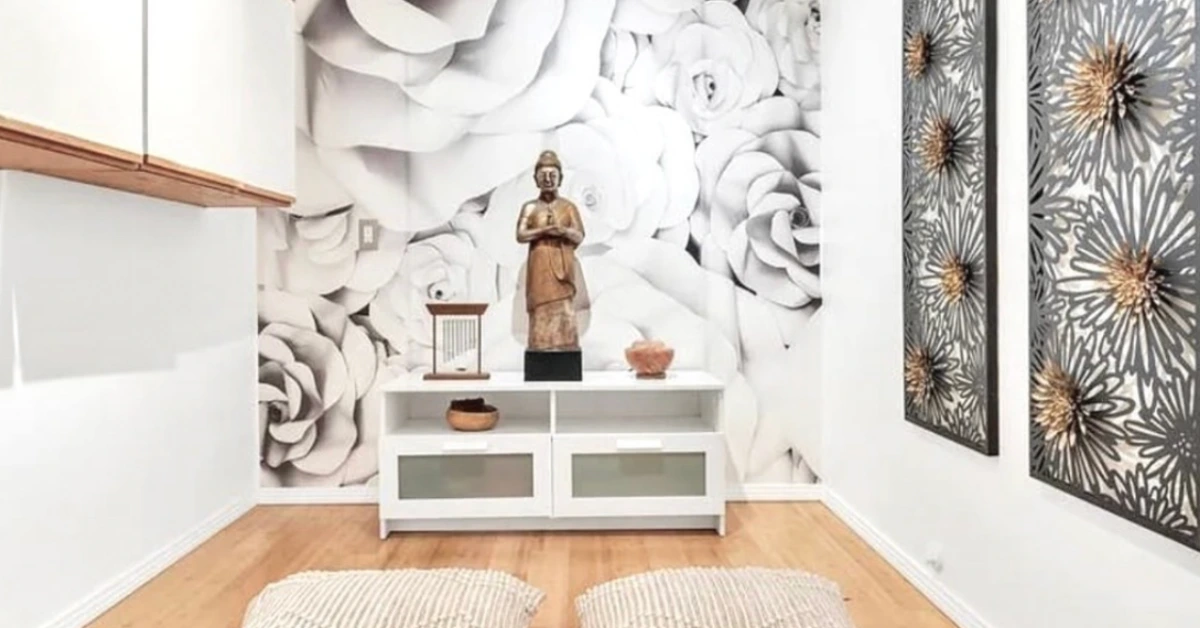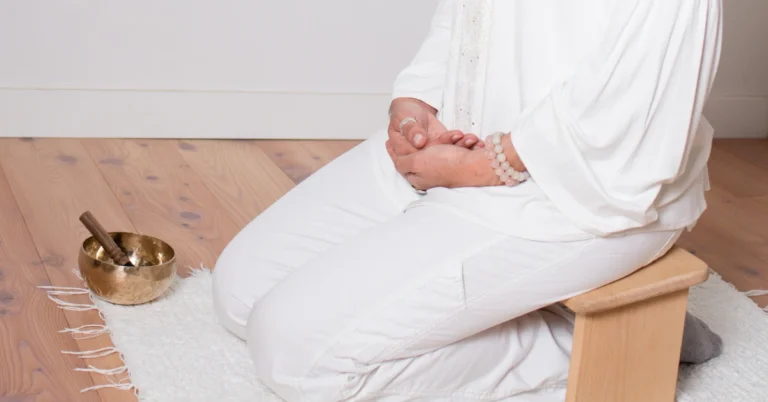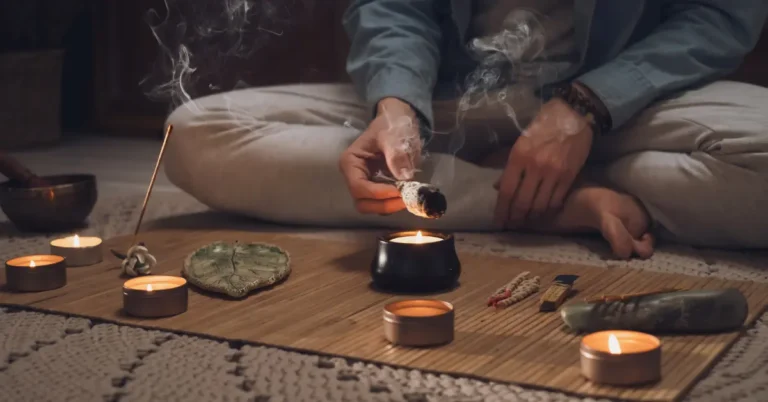Step into the serene universe of tranquility with our exploration of “Zen Colors for Meditation Room.” Imagine a space where every hue is carefully chosen to evoke a sense of calm, balance, and mindfulness.
In a world bustling with chaos, your meditation room becomes a sanctuary. The selection of colors isn’t just aesthetic; it’s a deliberate choice to enhance your meditation experience. From the calming embrace of blues to the grounding energy of earthy tones, each color carries a unique significance.
This article is your guide to creating a meditation space that harmonizes with the principles of Zen. We’ll delve into the psychology of colors, offering insights into how specific hues can elevate your practice. Join us on this colorful journey as we transform your meditation room into a haven of peace and serenity. Let the exploration of Zen colors for meditation room begin, and may your meditation space radiate the tranquility you seek.
Pros ✅
✅ The cushion set includes an extra free cover
✅ Filled by 100% top-grade buckwheat hull
✅ Layer of foam offers a soft landing
Cons 🚫
🚫 The velvet cover may not be as durable as the cotton cover
🚫 The cushion may be too firm for some users
Understanding Zen Colors For Meditation Room
As someone who practices meditation regularly, I have come to understand the importance of creating a peaceful and calming environment in my meditation room. One way to achieve this is by incorporating Zen colors into the room’s decor. Zen colors are hues that evoke a sense of tranquility, balance, and harmony, making them ideal for meditation spaces.
Some of the most popular Zen colors include:
- White: This color represents purity, clarity, and simplicity. It is often used in Zen meditation rooms to create a sense of spaciousness and openness.
- Plum: This dark shade of purple is associated with spirituality and is said to promote inner peace and relaxation.
- Mint: This soft green hue is calming and refreshing, making it an excellent choice for meditation spaces.
- Yellow: This sunny color is uplifting and energizing, making it an ideal choice for those who want to feel invigorated during their meditation practice.
- Sage: This muted green color is soothing and calming, promoting a sense of tranquility and balance.
When choosing Zen colors for meditation room, it’s essential to consider the overall ambiance you want to create. For example, if you want a minimalist and clutter-free space, you may opt for white or pale yellow. On the other hand, if you want a cozy and warm atmosphere, you may choose a darker shade of purple or green.
Importance of Zen Colors in Meditation Room

- As someone who practices meditation regularly, I have found that the colors in my meditation room play a significant role in my practice. Zen colors, in particular, have been known to enhance the overall meditation experience, creating a calming and peaceful atmosphere that helps to clear the mind and promote relaxation.
- One of the primary reasons why Zen colors are so effective in a meditation room is that they are inspired by nature. These colors are often associated with natural elements such as water, earth, and sky, and are believed to have a soothing effect on the mind and body. For example, shades of blue and green can create a sense of tranquility, while warm colors like yellow and orange can promote feelings of happiness and positivity.
- Another reason why Zen colors are so important in a meditation room is that they can help to create a sense of balance and harmony. By choosing colors that complement each other, you can create a cohesive and calming environment that promotes relaxation and inner peace. For example, you might choose to pair a soft blue with a muted green to create a sense of balance and harmony in your meditation space.
- Zen colors for meditation room can also help to set the mood for your meditation practice. By choosing colors that reflect the type of meditation you practice, you can create an environment that is conducive to your practice. For example, if you practice mindfulness meditation, you might choose to incorporate shades of blue and green into your meditation room to create a calming and peaceful atmosphere.
Choosing the Right Zen Colors For Meditation Room

When it comes to creating a meditation room, choosing the right colors is crucial. The colors you select can have a significant impact on your mood and overall experience. Here are some of the most popular zen colors for meditation room:
Neutral Tones
Neutral tones are a great choice for those who want a calming and relaxing atmosphere. These colors include white, beige, and gray. They are perfect for creating a minimalist and peaceful space that allows you to focus on your practice.
Earth Tones
Earth tones are another popular choice for zen colors for meditation rooms. These colors include brown, green, and tan. They are perfect for creating a natural and grounding atmosphere that connects you to the earth. Earth tones can help you feel more centered and in touch with your surroundings.
Cool Tones
Cool tones, such as blue and green, are excellent choices for meditation rooms. They can help you feel more relaxed and calm, and they are perfect for creating a serene atmosphere. Cool tones are ideal for those who want to create a peaceful and tranquil space that allows them to focus on their practice.
Warm Tones
Warm tones, such as orange and yellow, are perfect for creating a warm and inviting atmosphere in your meditation room. These colors can help you feel more energized and uplifted, and they are ideal for those who want to create a cozy and comfortable space that is conducive to meditation.
Incorporating Zen Colors For Meditation Room

When designing a meditation room, incorporating zen colors is key to creating a soothing and calming environment. Here are some tips on how to incorporate zen colors into your meditation room.
Color Balance
Color balance is essential when designing zen colors for meditation room. A balanced color scheme helps to create a harmonious and calming environment. When choosing colors, it’s important to consider the different hues and how they work together.
One way to achieve color balance is by using a color wheel. Complementary colors, such as blue and orange or green and red, are opposite each other on the color wheel and create a harmonious balance when used together. Analogous colors, such as blue and green or yellow and orange, are next to each other on the color wheel and also work well together.
Color Harmony
Color harmony is another important aspect of designing a meditation room. Harmony is achieved by using colors that are similar in hue, saturation, and brightness. This creates a sense of unity and balance in the space.
One way to achieve color harmony is by using a monochromatic color scheme. This involves using different shades and tints of the same color. For example, using different shades of blue can create a calming and serene atmosphere in the room.
Color Contrast
Contrast is also important when designing zen colors for meditation room. Contrast is created by using colors that are opposite each other on the color wheel, such as black and white or blue and orange. This creates a sense of energy and movement in the space.
When using contrast, it’s important to use it sparingly. Too much contrast can be overwhelming and create a sense of chaos in the space. A good rule of thumb is to use a maximum of three colors in the room, with one color being dominant and the others used as accents.
By incorporating color balance, color harmony, and color contrast, you can create a zen and calming environment in your meditation room.
Effects of Zen Colors For Meditation Room

As a meditation practitioner, I understand the importance of creating a calming and peaceful environment. One way to achieve this is by incorporating Zen colors into your meditation room. Zen colors have a profound effect on our mental, emotional, and physical well-being. In this section, I will discuss the psychological, emotional, and physical effects of Zen colors on meditation.
Psychological Effects
Zen colors have a calming effect on the mind. When we surround ourselves with Zen colors, we feel more relaxed, centered, and focused. These colors have a soothing effect on the nervous system, reducing stress and anxiety. When we meditate in a room with Zen colors, we are better able to quiet the mind and enter a deeper state of meditation.
Emotional Effects
Zen colors have a profound effect on our emotions. Different colors have different emotional associations. For example, blue is associated with calmness and serenity, while green is associated with balance and harmony. When we meditate in a room with Zen colors, we are better able to connect with our emotions and process them in a healthy way.
Physical Effects
Zen colors for meditation room have a physical effect on our bodies. When we surround ourselves with Zen colors, we experience a sense of relaxation and calmness. This relaxation response has a positive effect on our physical health, reducing blood pressure, heart rate, and muscle tension. When we meditate in a room with Zen colors, we are better able to access the healing power of our bodies and minds.
Maintaining Zen Colors in Meditation Room

As I create my own meditation room, it is important to maintain the zen colors that promote calmness and relaxation. Here are some tips to help me achieve this:
1. Stick to a Color Scheme
I will choose a color scheme that consists of calming colors such as pale green, mint, sky blue, or lavender, which will help me to feel relaxed and at ease. I will stick to this color scheme when selecting furniture, decor, and accessories for my meditation room.
2. Keep it Simple
It is important to keep my meditation room simple and free of clutter. I will only include the essential items such as a comfortable meditation cushion, a blanket, and a few decorative items that complement the color scheme.
3. Use Natural Materials
I will choose natural materials such as bamboo or wood for furniture and accessories. This will help to create a natural and calming atmosphere in my meditation room.
4. Avoid Bright Colors
I will avoid using bright colors such as red or orange, as they can be too stimulating and distracting. Instead, I will stick to the calming colors that promote relaxation and calmness.
5. Lighting
Lighting is an important factor in maintaining a zen atmosphere in my meditation room. I will use soft lighting such as candles or dimmer switches to create a peaceful and calming environment.
By following these tips, I can maintain the zen colors for meditation room, which will help me to feel relaxed and at ease during my meditation practice.
FAQ
What are Zen colors for meditation room, and how do they contribute to a meditation room’s ambiance?
Zen colors are hues inspired by nature, emphasizing simplicity and harmony. Common Zen colors include earthy tones such as muted greens, soft blues, warm browns, and calming grays. These colors are chosen to create a serene and tranquil atmosphere in a meditation room, promoting a sense of calm and balance.
Can I personalize the Zen colors for meditation room, or are there specific guidelines to follow?
While there are traditional Zen colors, personalization is encouraged. The key is to choose colors that resonate with you and evoke a sense of peace. Incorporating a palette that aligns with your preferences while maintaining a harmonious balance can enhance the effectiveness of the meditation space.
How do Zen colors for meditation room impact the meditation experience, and are there specific colors recommended for relaxation and focus?
Zen colors for meditation room are selected for their ability to promote relaxation and focus during meditation. Muted greens and blues, for instance, are often associated with tranquility, while soft grays and earthy tones create a grounding effect. The choice of colors can influence the overall mood of the room, supporting a calm and focused meditation experience.
Can Zen colors for meditation room be combined, or is it recommended to stick to a single color scheme in a meditation room?
Zen colors for meditation room can be combined thoughtfully to create a balanced and harmonious environment. Consider using a primary color as the base and complementing it with accents from a related palette. The goal is to maintain simplicity and avoid overwhelming the space. Experiment with combinations that evoke a sense of peace and serenity for your unique meditation room.
If you liked this blog article about zen colors for meditation room, don’t forget to follow us on Pinterest so you don’t miss any more meditation news!






